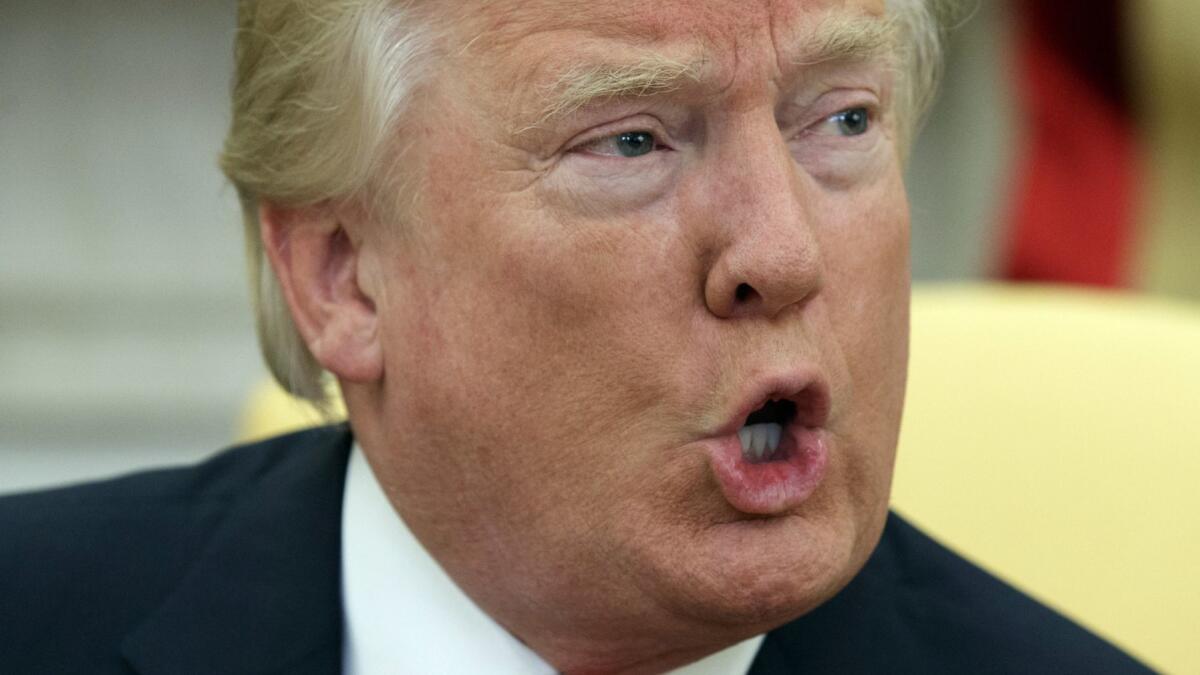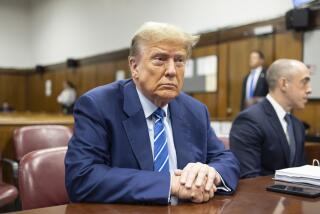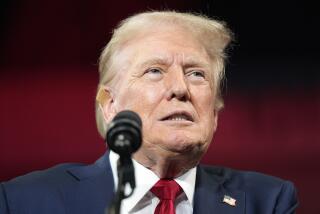Supreme Court leans toward upholding Trump’s third try at a travel ban

Reporting from Washington — The Supreme Court’s conservative justices sounded ready Wednesday to uphold President Trump’s travel ban, potentially giving the embattled White House a big legal victory after a series of defeats in the lower courts.
Chief Justice John G. Roberts Jr. and Justice Anthony M. Kennedy portrayed the issue before the court as one of national security in which the chief executive, not the judicial branch, should be entrusted to weigh possible threats from foreign visitors.
“Could the president ban the entry of Syrian nationals” if he had evidence that some Syrians had chemical or biological weapons? Roberts asked a lawyer challenging Trump’s travel ban.
Even the lawyer for the challengers had to agree the answer was yes.
But attorney Neal Katyal, representing the state of Hawaii, said federal law gives the president only temporary authority to exclude certain people, not to impose a broad ban that would cover an entire nation and stay in place indefinitely.
The president should go to Congress if he wants a “flat ban” on new immigrants from certain nations, Katyal said.
“Imagine, if you can, that Congress is unable to act when the President asked for legislation,” Roberts said to laughter in the courtroom. He suggested the immigration laws authorize the president to bar foreign travelers to protect the nation’s security.
Kennedy said he did not see why the president’s order had to have a time limit. “Do you want the president to say: ‘I’m convinced in six months we will have a safe world?’” he said in a sarcastic rejoinder.
At issue now is the third version of a travel ban. It bars the entry of most immigrants and travelers from Iran, Syria, Yemen, Somalia, Libya and North Korea as well as officials from Venezuela. Earlier versions included Chad, Sudan and Iraq.
Since Trump first issued his travel order, setting off widespread chaos at airports just a few days after his inauguration, the issue has strongly shaped public perceptions of the new administration. It has also led to a string of defeats in lower courts, where judges ruled that the measure exceeded Trump’s authority and, in some cases, said it reflected bias against Muslims.
The Supreme Court has provided a friendlier forum, however. The justices issued a ruling in June that allowed the second version of the travel ban to take partial effect. Then, in December, with only two dissents, they set aside lower-court rulings to allow the administration to put the third version into practice, a strong indicator of where the majority was headed.
Wednesday, along with Roberts and Kennedy, two other members of the court’s conservative wing clearly seemed inclined to uphold Trump’s order. Along with Justice Clarence Thomas, who made no comments, they would appear to provide five solid votes to provide the administration with a victory.
Justice Samuel A. Alito rejected the notion Trump’s order could be considered a “Muslim ban,” noting it does not apply to most of the largest Muslim nations.
“If you look at what was done, it does not look like a Muslim ban,” he said.
Justice Neil Gorsuch, Trump’s appointee, questioned whether the challengers had standing to sue in the first place. Foreigners overseas do not have rights in U.S. courts, he said. Plaintiffs who live in Hawaii sued, contending the travel ban was illegal, but “third parties can’t vindicate the rights of aliens,” Gorsuch said.
During the first half-hour of the argument, the court’s liberals, led by Justices Elena Kagan and Sonia Sotomayor, suggested Trump’s order reflected unconstitutional religious bias.
“So let’s say in some future time, a president gets elected who is a vehement anti-Semite and says all kinds of denigrating comments about Jews,” Kagan said in a question posed to Solicitor Gen. Noel Francisco.
And suppose the new president then issues “a proclamation that says no one shall enter from Israel.” What are “reasonable observers” to think? she asked.
“It’s a tough hypothetical,” Francisco conceded. “But it’s why I think that this is a relatively easy case.”
The current version of the travel ban emerged from a “multi-agency review” and a recommendation from the president’s Cabinet, he said. “This is not a so-called Muslim ban. If it were, it would be the most ineffective Muslim ban since...it excludes the vast majority of the Muslim world.”
Sotomayor said she was unimpressed with the claim that the travel ban came from a multi-agency review and not solely from the president.
“He can hire and fire anyone he wants,” she said, adding that a president could dictate to Cabinet officials what they should approve.
Francisco said the president’s Cabinet officers are “duty-bound to protect and defend the Constitution” and “would resign in the face of a plainly unconstitutional order.”
Several justices commented on Trump’s campaign statements and his tweets, asking if they gave evidence of anti-Muslim bias.
The president’s lawyer argued that campaign statements are a matter of free speech and not relevant in judging a president’s decisions in office.
At one point, Kennedy disagreed, saying that campaign statements were not “irrelevant” in judging the actions of an elected official.
But during the second half of the argument, the five conservatives steered away from the issue of bias.
And any hope the challengers had that Kennedy, who most often holds the court’s swing vote, might side with them dwindled quickly.
At one point, Kennedy stared at Katyal as he said: “Your argument is the courts have a duty to review whether or not there is a national exigency. That’s for the courts to do, not the president?” His tone suggested the argument was not one he accepted.
In addition to resolving the fate of the travel order, the ruling in the case may give the first clues about how the high court is reacting to the tempestuous Trump presidency — and to the determined legal resistance in the lower courts.
During the tenures of Presidents George W. Bush and Obama, nearly four years went by before the high court weighed in on their uses of presidential power. For Bush, the “war on terror” provided the first, key test. For Obama, it was his healthcare law.
Both times, the court narrowly upheld the president’s initiatives, but with limits. Prisoners at the U.S. military base in Guantanamo Bay, Cuba, won the right to court hearings, and Republican states won the right not to expand their Medicaid coverage.
By contrast, the fight over the travel ban began a few days after Trump’s inauguration, when the White House issued a hastily drafted proclamation that critics said was an attempt to make good on his campaign promise to enact a “Muslim ban.” The order barred travelers from seven predominantly Muslim countries and disrupted travel for thousands of tourists, students, family members and business travelers.
Katyal, who served as acting solicitor general under Obama, is leading the challenge. He argues that Trump’s order is extraordinary and unwarranted.
Trump “seeks to impose a sweeping change to the immigration system, imposing a ban on the entry of 150 million aliens — the vast majority of them Muslim,” he told the court in briefs filed in Trump vs. Hawaii.
Giving the president such “extravagant and unilateral authority” would mean the chief executive could pick and choose which countries may send visitors to this country, Katyal said. Congress specifically rejected such discrimination based on nationality in 1965, he noted.
By contrast, Francisco, representing the administration, said Trump’s order is a routine measure in line with law and tradition.
“The Constitution and acts of Congress both confer on the president broad authority to suspend or restrict the entry of aliens outside the United States when he deems it in the nation’s interest,” he wrote.
“Past presidents have routinely invoked that authority … to advance national security and foreign policy objectives,” he wrote. He cited as examples President Carter’s order barring Iranians in the late 1970s and President Reagan’s order blocking Cubans in the mid-1980s.
The high court is being asked to rule on four questions — two substantive and two procedural.
First, Trump’s lawyers question whether anyone can go to court to challenge an executive order barring entry of a noncitizen. “Congress has never authorized judicial review” of executive decisions “to exclude aliens abroad,” Francisco said. These noncitizens “have no constitutional rights regarding entry,” he added.
Katyal disagrees, of course. The judiciary is not “powerless” to intervene when the president oversteps his legal authority and adopts an unconstitutional policy, he said.
The next question focuses on federal immigration law and what it authorizes. Trump’s lawyers say Congress gave the president broad authority to “suspend the entry” of “any class of aliens” whenever he sees fit and for as long as he “shall deem necessary.”
Katyal agrees that the law gives the president this power, but says the authority applies to temporary and emergency measures, not a permanent ban. He also says the president has failed to explain why the travel ban is needed.
Moreover, Katyal points to the section of immigration law adopted in 1965 that he says makes clear the president may not “single-handedly revive the national quota system” that Congress abolished.
The third question asks whether a limitation targeted at Muslim countries violates the Constitution’s ban on an “establishment of religion.” Usually, the “establishment of religion” issue arises when local officials choose to hold prayers at public events or put religious symbols on public property.
In this case, Francisco says the travel ban is “religion neutral” because it singles out countries based, not on religion, but on their lack of strong security procedures.
Katyal says the “evidence is overwhelming that [the travel ban order] was issued for the unconstitutional purpose of excluding Muslims from the United States.”
Finally, Trump’s lawyers ask the court to decide whether the district judge’s order in Hawaii that blocked the travel ban nationwide was too broad. The administration hopes the court will rein in the increasingly common practice of district judges handing down nationwide orders based on a suit brought by a handful of plaintiffs.
More stories from David G. Savage »
Twitter: DavidGSavage
UPDATES:
1:30 p.m.: This article was updated with additional remarks from the argument and analysis.
9:50 a.m.: This article was updated with remarks by Justice Kagan.
8:40 a.m.: This article was updated with details from the Supreme Court argument.
This article was originally published at 3 a.m.
More to Read
Get the L.A. Times Politics newsletter
Deeply reported insights into legislation, politics and policy from Sacramento, Washington and beyond. In your inbox three times per week.
You may occasionally receive promotional content from the Los Angeles Times.











